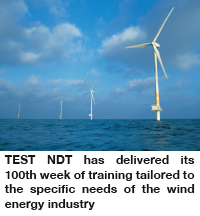Wind energy NDT training reaches milestone
02/03/2015
TEST NDT has recently completed its 100th week of formal training for the inspection of wind energy structures.  These specialised training courses were initially developed almost 10 years ago following a request from a major wind turbine blade manufacturer for the development of a specialised training curriculum for the inspectors of composite blades of wind turbines. TEST NDT was chosen because of the composite experience and expertise of its key employees. Although the experience at the time was mainly in the aircraft and aerospace industry sectors, the principles of manufacture and defect types are similar in many instances, which allowed existing material to be modified and adapted accordingly.
These specialised training courses were initially developed almost 10 years ago following a request from a major wind turbine blade manufacturer for the development of a specialised training curriculum for the inspectors of composite blades of wind turbines. TEST NDT was chosen because of the composite experience and expertise of its key employees. Although the experience at the time was mainly in the aircraft and aerospace industry sectors, the principles of manufacture and defect types are similar in many instances, which allowed existing material to be modified and adapted accordingly.
The training and qualification process was developed by TEST NDT in accordance with ASNT document SNT-TC-1A, which was chosen because of its ability to be ‘modified with flexibility and reason’. This facility was essential to allow the standard training package to be modified to suit the specific requirements of the wind energy industry and products. The training is primarily focused on the ultrasonic techniques of B-scans using specially-developed, encoded bubbler probes and C- and S-scan techniques using specially-developed phased array probes, using custom-built water-irrigated probe systems.
TEST NDT was responsible for the development and approval of these techniques several years ago, and they have been revised and improved several times during this period following the implementation of new technology and the increased range of blade types being manufactured.
Initial blade inspection processes involved using encoded B-scan techniques on a sampling basis, but these have been replaced almost entirely by phased array scanning techniques using specially-developed water-irrigated probes. This allows for 100% coverage of the areas of interest in a short period of time. Some of the blades currently being inspected using these techniques are now in excess of 73 m per blade, so high-speed inspection techniques are essential.
On-going development work involves the implementation of roller probe techniques for even greater efficiencies in the inspection process.
The use of phased array inspection techniques and equipment also allows the evaluation of the data files using PC-based software systems and the archiving of all data gathered during the inspections.
TEST NDT has worked with several blade manufacturers and inspection companies to provide consultation, training, Level 3 services and qualification services for the rapidly-expanding wind energy industry sector. To date, this training package has been provided in eight different countries on four different continents and another 12 weeks of training has been scheduled for the first quarter of 2015.
www.testndt.com